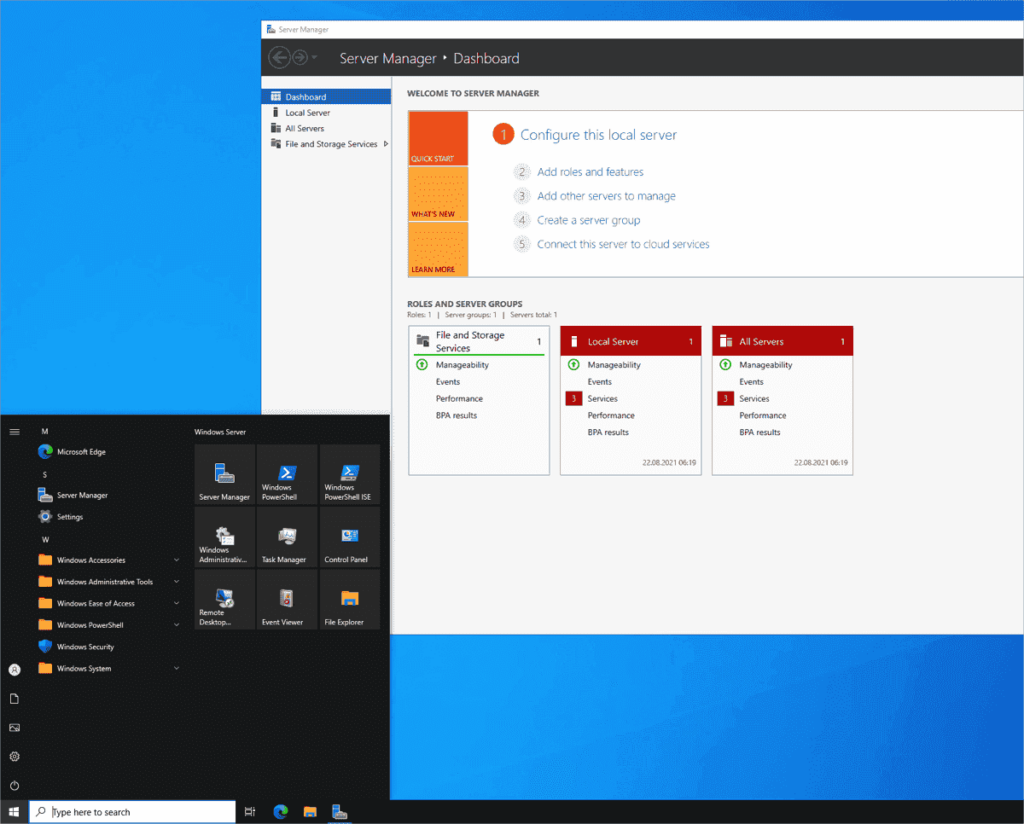Windows Server 2022, the latest version of Microsoft’s server operating system, was released in September 2021. This new release includes a wide range of features, improvements, and upgrades, making it an exciting prospect for businesses and organizations looking to improve their IT infrastructure. In this review, we’ll take a closer look at the significant features of Windows Server 2022.

Table of Contents
Installation and Setup
The installation and setup process of Windows Server 2022 is relatively straightforward and similar to previous versions. The system requirements have increased slightly, but the installation process itself remains largely unchanged. One significant improvement is the ability to install the operating system using virtualization platforms such as Hyper-V, VMware, and VirtualBox, making it easier to deploy in virtual environments.
Security Enhancements
Security is always a critical concern for any organization, and Windows Server 2022 includes several enhancements to improve security. One of the most significant improvements is the introduction of a secured-core server. Secured-core servers are designed to provide an extra layer of security, protecting against firmware and hardware-level attacks. This feature is particularly useful for organizations that deal with sensitive data or operate in industries with strict security regulations.
Another essential security improvement in Windows Server 2022 is the introduction of passwordless authentication. This new feature allows users to sign in using biometric authentication, such as facial recognition or fingerprint scanners, rather than a traditional password. Passwordless authentication is more secure than traditional passwords, as biometric data is unique to each user and cannot be easily replicated.
Storage Features
Windows Server 2022 includes several storage improvements that are beneficial to organizations of all sizes. The introduction of SMB compression allows for more efficient data transfer, reducing network traffic and storage requirements. Another critical storage enhancement is the ability to mount persistent memory as a drive, providing faster access to frequently used data. This feature is particularly useful for applications that require high-speed access to data.
Storage Spaces Direct (S2D) is also improved in Windows Server 2022. S2D is a software-defined storage solution that allows for the creation of highly available storage clusters using commodity hardware. The new release of Windows Server 2022 includes several improvements to S2D, including performance enhancements, support for larger deployments, and better integration with Azure.
Hybrid Cloud Integration
As more organizations adopt hybrid cloud environments, Microsoft has made several improvements to Windows Server 2022 to make it easier to integrate with cloud platforms. Azure Arc is a new feature that allows organizations to manage Windows Server instances deployed in on-premises, multi-cloud, and edge environments from a single pane of glass. This feature provides a centralized management experience, making it easier to monitor and manage resources across different environments.
Another critical hybrid cloud improvement in Windows Server 2022 is the ability to use Azure as a backup target. This new feature allows organizations to use Azure as a backup destination, providing an additional layer of protection for critical data. The integration with Azure also allows for more efficient backups, reducing the time required to restore data in the event of a disaster.
Virtualization Enhancements
Virtualization is an essential part of many organizations’ IT infrastructure, and Windows Server 2022 includes several virtualization improvements. One of the most significant improvements is the introduction of virtualized hybrid network capabilities. This new feature allows organizations to extend their virtual networks to Azure, making it easier to move workloads between on-premises and cloud environments.
Another critical virtualization improvement is the ability to run Linux containers on Windows Server. This new feature allows organizations to run Linux containers alongside Windows containers, providing more flexibility in application deployment. The inclusion of Linux support is an essential step for Microsoft, as more organizations move towards containerized application architectures.
Improved Application Platform
Windows Server 2022 also includes several improvements to the application platform, making it easier for developers to build and deploy applications. One of the most significant improvements is the inclusion of .NET 6, the latest version of Microsoft’s flagship development framework. .NET 6 includes several new features and improvements, such as better performance, improved scalability, and enhanced support for microservices.
Another essential improvement in the application platform is the inclusion of OpenSSH. OpenSSH is a popular open-source tool used for secure remote access and file transfer. Its inclusion in Windows Server 2022 makes it easier for organizations to manage their server infrastructure securely.
Other Significant Features
In addition to the improvements listed above, Windows Server 2022 includes several other significant features. These features include:
- GPU acceleration: Windows Server 2022 includes support for GPU acceleration, allowing for faster processing of workloads that require graphics processing, such as machine learning and data analytics.
- Windows Admin Center: Windows Admin Center is a web-based tool that provides a centralized management experience for Windows Server. The tool includes several new features in Windows Server 2022, such as support for Azure Arc and S2D management.
- Improved Remote Desktop Services: Remote Desktop Services (RDS) is an essential component of many organizations’ IT infrastructure. Windows Server 2022 includes several improvements to RDS, such as better performance, improved scalability, and support for the latest security protocols.
- Improved Windows Subsystem for Linux (WSL): WSL allows users to run Linux applications directly on Windows Server. Windows Server 2022 includes several improvements to WSL, such as better performance and improved support for Docker containers.
Conclusion
Windows Server 2022 is a significant release for Microsoft, offering a wide range of improvements and new features. The enhanced security, storage, hybrid cloud integration, virtualization, and application platform capabilities make it an attractive prospect for organizations looking to improve their IT infrastructure. The new features, such as secured-core servers, passwordless authentication, and Azure Arc, provide organizations with better tools to protect and manage their resources. The improvements to virtualization, including virtualized hybrid networking and Linux container support, make it easier to deploy and manage applications. Overall, Windows Server 2022 is a robust and feature-rich operating system that is well worth considering for any organization’s IT infrastructure.

